Last Updated on 26th April 2025 by peppe8o
This tutorial will show you how to install Grocy on a Raspberry PI computer board, showing all the required commands to get it up and running.
About Grocy
Managing home stocks is a common need for all people. How many times did you forget to buy something you finished at home from your market?
Grocy aims to help people keep track of their stocks and easily plan shopping for required items. With its built-in barcode scan function, it also allows managing the number of your products by simply scanning their barcode with your smartphone/tablet/PC camera.
It also supports a wider number of items and elements, also letting you define your customised ones.
Its main features include:
- Google Home Assistant integration
- Purchases tracking
- Shopping list automation and optimisation
- Recipes management
- Meal planning
- Tasks management
- … and many other features and addons
In this guide, Grocy will be installed on a Raspberry PI 5 Model B, but this should work with any Raspberry PI computer board.
What We Need
As usual, I suggest adding from now to your favourite e-commerce shopping cart all the needed hardware, so that at the end you will be able to evaluate overall costs and decide if to continue with the project or remove them from the shopping cart. So, hardware will be only:
- Raspberry PI Computer Board (including proper power supply or using a smartphone micro USB charger with at least 3A)
- high speed micro SD card (at least 16 GB, at least class 10)
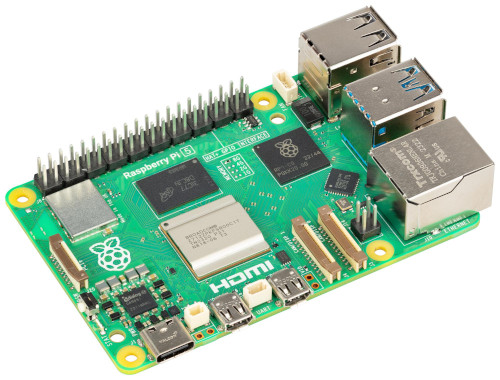
Step-by-Step Procedure
Prepare the Operating System and Required Packages
The first step is installing the Operating System. I suggest you use the Raspberry PI OS Lite (please note that we need the 64-bit version) to get a fast and light operating system (headless). In this case, you will need to work from a remote SSH terminal. If you need a desktop environment, you can also use the Raspberry PI OS Desktop, in this case working from its terminal app. The links provide you with the procedures for both the OSes.
Please find the differences between the 2 OS versions in my Raspberry PI OS Lite vs Desktop article.
Make sure that your system is up to date. Connect via SSH terminal and type the following command:
sudo apt update -y && sudo apt full-upgrade -yThe following command will also install all the packages you need to run Grocy (Apache, SQLite, and PHP, including its extensions):
sudo apt install apache2 sqlite3 php php-sqlite3 php-gd php-intl php-mbstring -yInstall Grocy on your Raspberry PI
Get a copy of the Grocy package:
wget https://releases.grocy.info/latest -O grocy.zipUnzip to the Apache root folder, copy the config file from the template and give the correct permissions to the folder:
sudo unzip grocy.zip -d /var/www/html/
sudo cp /var/www/html/config-dist.php /var/www/html/data/config.php
sudo chown www-data:www-data -R /var/www/html/Define the base path in Apache:
sudo nano /etc/apache2/sites-available/000-default.confedit from
DocumentRoot /var/www/htmlto:
DocumentRoot /var/www/html/publicSave and close this file.
Enable Override in Apache:
sudo nano /etc/apache2/apache2.confEdit within the “<Directory /var/www>” section:
AllowOverride Noneto
AllowOverride AllSave and close this file.
Enable Rewrite and restart Apache:
sudo a2enmod rewrite
sudo systemctl restart apache2.serviceFrom your favourite browser, use your Raspberry PI URL: “http://<<YourRpiIpAddress>>” (my Raspberry PI address is 192.168.1.218). The login page will appear:

Use the default credentials (remember to change the password soon when you start using Grocy with your info):
- user: admin
- password: admin
You will be logged into the Grocy default home page:
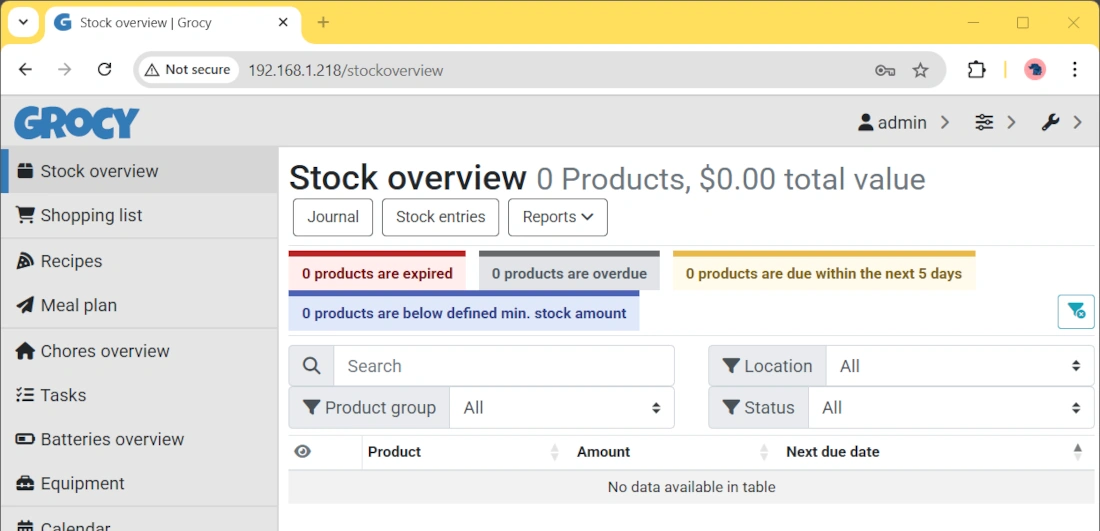
From here, you can use your Grocy installation.
Change User Password
As you can see, Grocy uses a default password, which is insecure by default. You should change it as soon as you have Grocy installed on your Raspberry PI. To accomplish this job, please use the “Change password” link available in your user menu on top right as highlighted in the following screenshot:
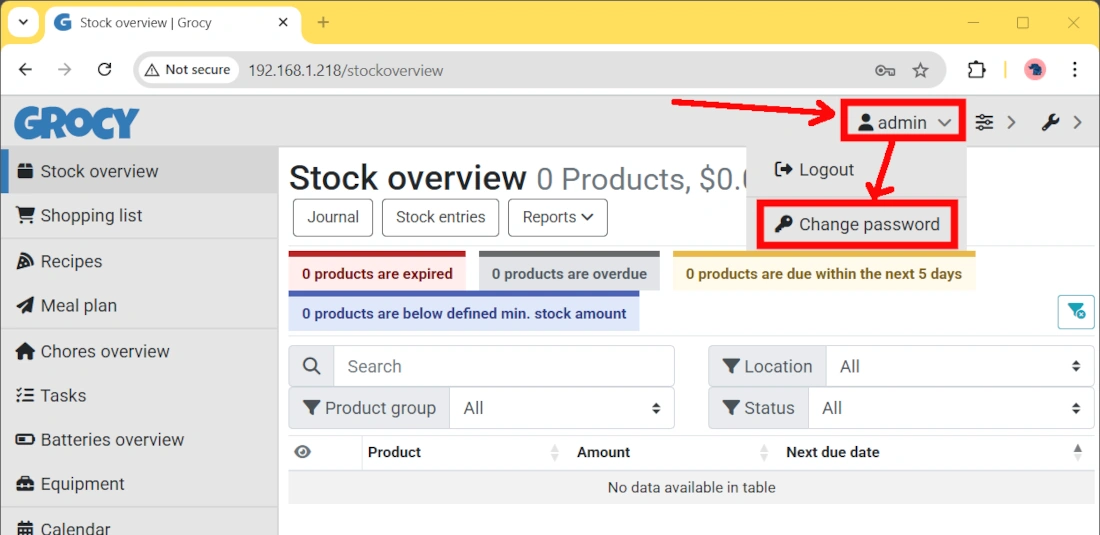
The resulting page will enable you to customise your username, Name, Surname and password, as well as add a picture for your user:
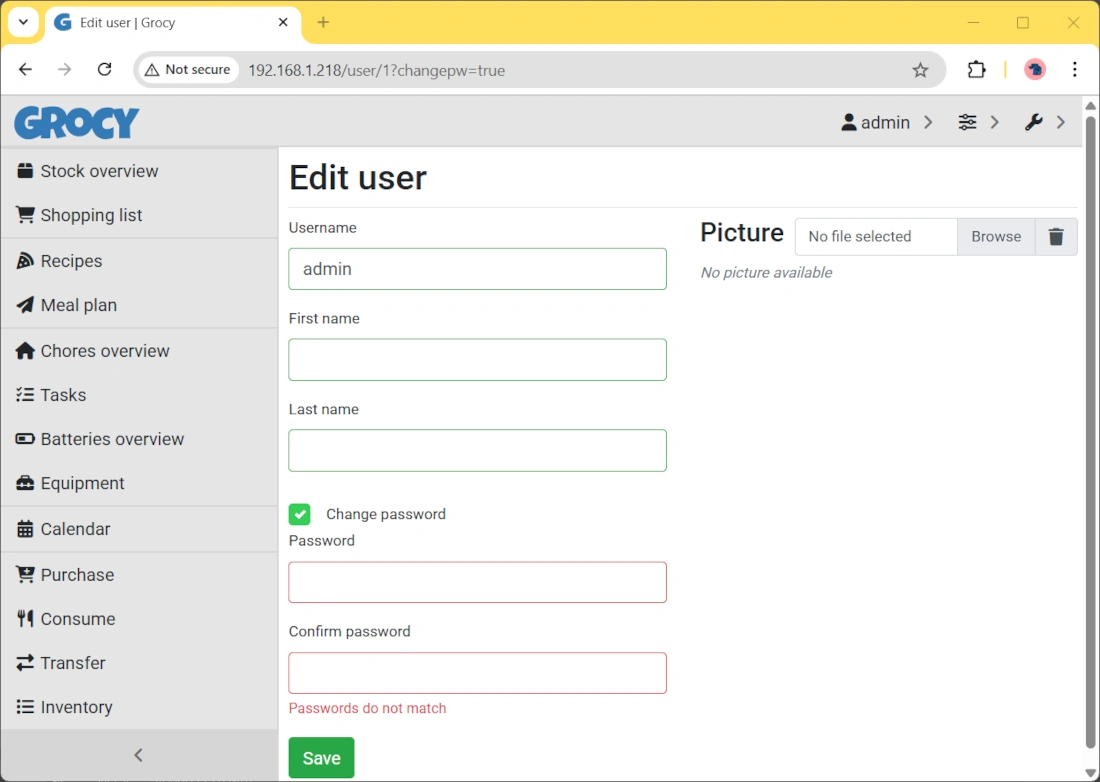
As you add and confirm the password, please use the “Save” button at the end of the form to make the changes effective. When done, you will be redirected to the Users page, showing you the only user currently configured:
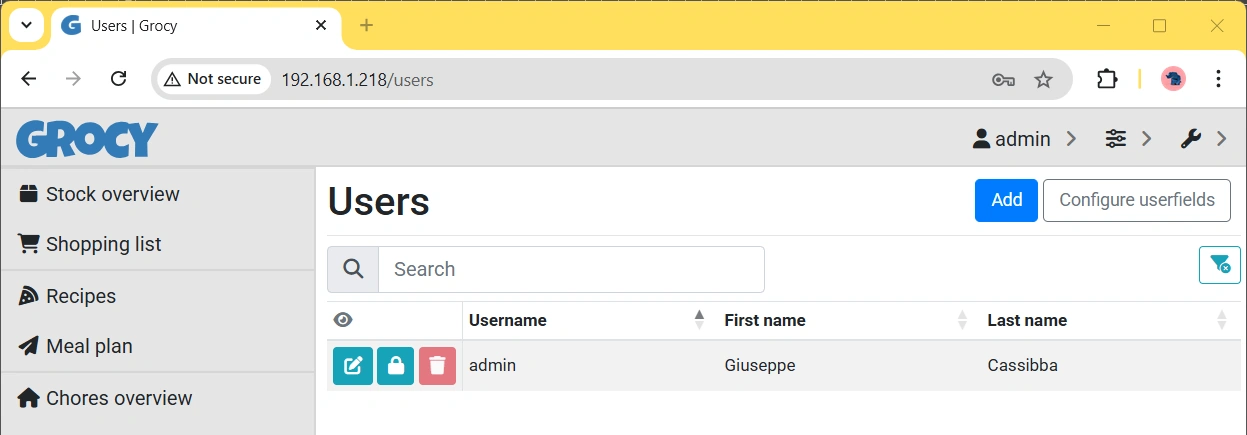
At any time, you can use this page to add new users or manage the existing ones by selecting the “Manage users” link from the configuration menu:
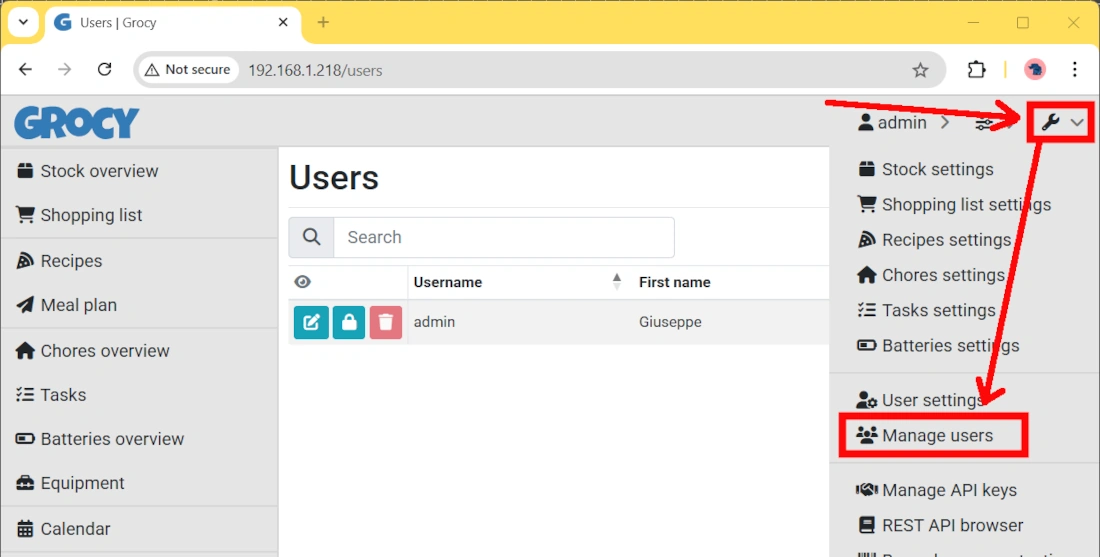
Enabling Barcode Scanner
If you want to use the convenient Barcode Scanner feature, you need to move your Grocy installation to “https“. To enable SSL and make the barcode scan work, you have 2 options: you can enable a Raspberry PI self-signed certificate or, if your Grocy installation is published on the web, you can use a Let’s Encrypt certificate. Both solutions are free, but each one has its PROs and CONs.
With self-signed certificates, you can use them in a local environment (not exposed on the web), but you will have warnings in your browser if the client can’t verify the certificate with a third-party certification authority.
With Let’s Encrypt certificates, you can use Grocy without any browser warnings, but you need to deal with exposing your Grocy service on the internet, so you require a public IP address and managing your router’s port forwarding and getting a domain (like the free NO-IP domains). So, this solution will require a bit more expertise to make the stack work.
In the following, I will explain to you the steps for the first option (self-signed certificate).
Please enable the Apache SSL, create a folder for certificates and generate the local certificates with the following 3 commands:
sudo a2enmod ssl
sudo mkdir /etc/apache2/ssl
sudo openssl req -x509 -nodes -days 365 -newkey rsa:2048 -keyout /etc/apache2/ssl/apache.key -out /etc/apache2/ssl/apache.crtThe last command will ask some questions for the certificate generation. Answers are free and not mandatory.
Now, please setup the Apache SSL configuration file with the correct root directory. Open the following file for editing:
sudo nano /etc/apache2/sites-available/default-ssl.confIdentify the row including the DocumentRoot /var/www/html string and change it to DocumentRoot /var/www/html/public.
Save and close the file.
Enable SSL and restart Apache:
sudo a2ensite default-ssl.conf
sudo systemctl restart apache2.serviceBack to your browser, you will find the SSL page at “https://<<YourRpiIpAddress>>” (my address is still 192.168.1.218).
Your web browser will notify a not-verified certificate with a not secure warning. The message may vary according to your browser and the following screenshots are from Chrome.
As you are sure that this is your Raspberry PI and you’re in a secure environment (your home network), you can proceed with the “Advanced” button:
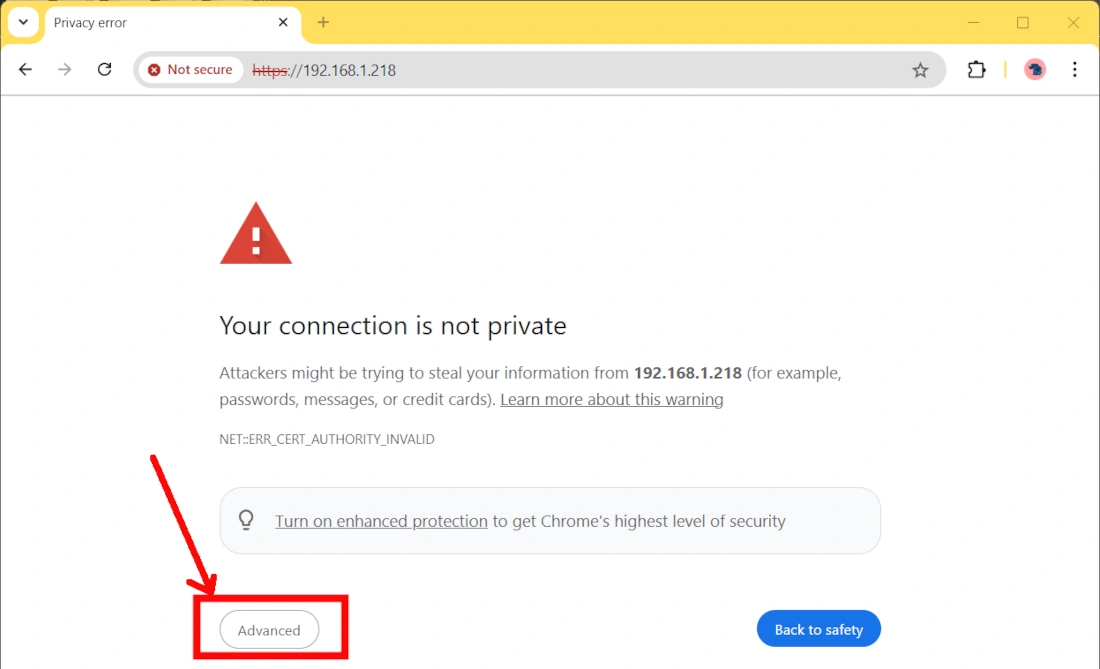
It will unhide the following section, allowing you to “Proceed to” your page:
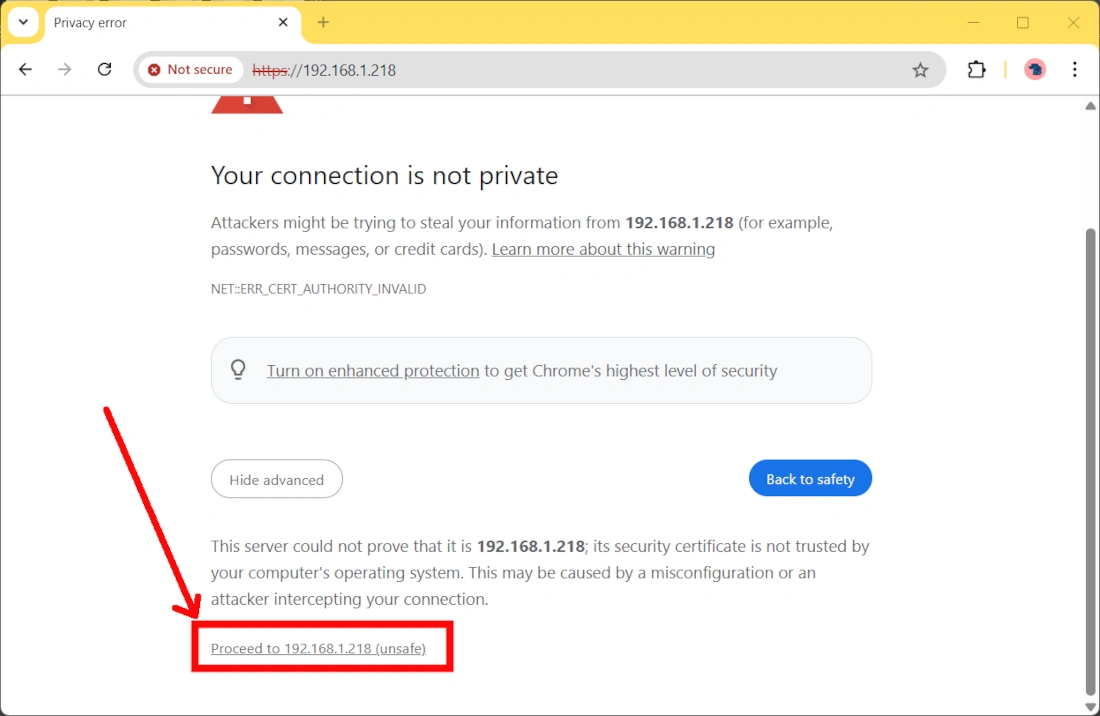
Please log in again (if you’re logged out) and select the “Barcode scanner testing” link in the configuration menu:
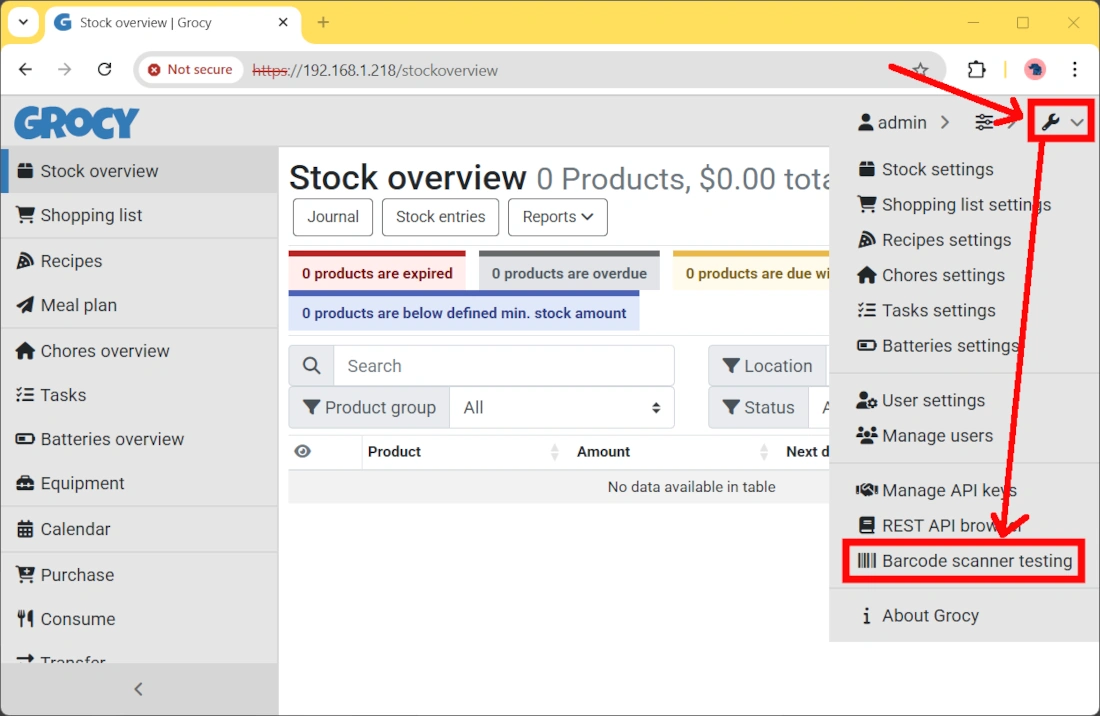
With this function, you can test the results from scanning barcodes with your camera. At the beginning, you will find the “Scan field” area disabled (greyed).
Please take a barcode from a product of your choice to test the scanner and digit the number under your product’s barcode in the “Expected barcode” area. Now, you can click the camera icon to show the barcode area in your PC’s camera or your smartphone’s camera. This page will show you the detected barcode and compare it with the expected one, showing missed/hit data coming from the barcode scanner. These steps are shown in the following screenshot:

From my tests, I noticed that scanning barcodes with my smartphone’s camera gave me better results compared with my PC’s camera.
Grocy Docs
Please find the Grocy tutorials at https://github.com/grocy/docs/blob/master/tutorial.md.
What’s Next
If you want to discover many other projects for your Raspberry PI, you can take a look at peppe8o Raspberry PI tutorials.
Enjoy!

Open source and Raspberry PI lover, writes tutorials for beginners since 2019. He's an ICT expert, with a strong experience in supporting medium to big companies and public administrations to manage their ICT infrastructures. He's supporting the Italian public administration in digital transformation projects.


Hello,
thank you for your guide.
I have two questions:
1. Can the section regarding the ssl certificate also applied to a nginx setup?
2. I’m trying to setup my grocy in a sub folder but I have no success. I read through the guides on the webpage but I’m not able to get this running in a sub-folder. So if would be very useful for me but I think also for others when you could show this step by step
Hi.
Nginx has its own security enablement procedure to enable certirifates, which can be generated with external free authority. They should be ok also from openssl command in this article, but I’ve not still tried it.
Regarding subfolder, you need also to update config.php file as referred in
https://github.com/grocy/grocy/issues/694.Let me know if this is helpful to you of if more help is needed
Hi,
thanks for the link to the nginx article. In the above article you create a ssl certificate without a real domain just in the terminal. In
//peppe8o.com/install-free-ssl-certificates-with-nginx/according to the guide I would need a real domain or not? Or can I just choose a random domain name which I don’t own and take the certificate and use it for securing my access to my local grocy service?!?I’m using grocy just in my home network and with VPN, so I just have a internal home network ip for this service.
The subfolder installation I tried several times. Either I can’t reach the page at all and only see a Nginx error or I see a page with Grocy logo and the text this page doesn’t exist and will reload in 5 seconds. I have already tried all configuration files adjusted to my installation paths but it was one of the two results every time.
Hi
Thanks for this tutorial. However when I run grocy it doesn’t work because the version of php installed is not good (requiered PHP 7.4). Do you plan to update the tutorial? I am a novice and despite my little research to install PHP 7.4 I am unable to make grocy work
Thank you very much for your note, David.
Unlucly, after recent Grocy upgrade it seems that php 7.3 is no more supported. On the other side, Raspberry PI apt sources still include only the obsolete php 7.3. For this reason I updated my tutorial adding a workaround. I tested it and appears to be working now. If you already installed php7.3 before, I suggest to purge these packages with “sudo apt purge php7.3*”
Hi,
Thank you for the tutorial 🙂
I’ve followed it “by the letter” but when I try to connect to grocy the first time I get a 403 error.
I did the chown www-data thing I can’t find a way to connect to grocy 🙁
any idea ?
Thanks
Ed
Hi Ed,
as you correctly investigated, 403 error means permissions issues.
Please enter the /var/www/html/ folder:
cd /var/www/html/and post (or email me at giuseppe@peppe8o.com) result from command:
ls -laThank you!
Hi peppe80
thanks for your quick answer 🙂
first of all, all my websites on the servers are installed directly on /var/www/… (not /var/www/html/…), maybe so grocy is installed at /var/www/grocy.mydomaine.com
might it be the source of the error ?
so concerning your request, ls -la output on the root of grocy folder is following :
total 244
drwxrwxr-x 13 www-data www-data 4096 avril 18 16:07 .
drwxr-xr-x 6 www-data www-data 4096 avril 18 11:06 ..
-rwxrwxr-x 1 www-data www-data 2649 janv. 5 10:51 app.php
drwxrwxr-x 2 www-data www-data 4096 janv. 5 10:52 changelog
-rwxrwxr-x 1 www-data www-data 10077 janv. 5 09:52 config-dist.php
drwxrwxr-x 3 www-data www-data 4096 janv. 5 09:52 controllers
drwxrwxr-x 4 www-data www-data 4096 avril 18 11:03 data
-rwxrwxr-x 1 www-data www-data 128962 janv. 5 09:52 grocy.openapi.json
drwxrwxr-x 2 www-data www-data 4096 janv. 5 09:52 helpers
-rw-r–r– 1 www-data www-data 155 avril 18 16:07 .htaccess
-rwxrwxr-x 1 www-data www-data 1090 mars 6 2019 LICENSE
drwxrwxr-x 28 www-data www-data 4096 janv. 5 10:44 localization
drwxrwxr-x 2 www-data www-data 4096 janv. 5 09:52 middleware
drwxrwxr-x 2 www-data www-data 4096 janv. 5 09:52 migrations
drwxrwxr-x 9 www-data www-data 4096 janv. 5 09:56 public
-rwxrwxr-x 1 www-data www-data 10646 janv. 5 09:52 README.md
-rwxrwxr-x 1 www-data www-data 16446 janv. 5 09:52 routes.php
drwxrwxr-x 2 www-data www-data 4096 janv. 5 09:52 services
-rwxrwxr-x 1 www-data www-data 968 avril 7 2020 update.sh
drwxrwxr-x 23 www-data www-data 4096 janv. 5 09:55 vendor
-rwxrwxr-x 1 www-data www-data 58 janv. 5 10:49 version.json
drwxrwxr-x 5 www-data www-data 4096 janv. 5 09:52 views
Re ^^
I checked further, changing apache root folder from /var/www/html to /var/www
I then clicked down to the grocy/public folder and this page appeared :
Error source:
“`
/var/www/grocy.toto.fr/services/DatabaseService.php:33
“`
Error message:
“`
SQLSTATE[23000]: Integrity constraint violation: 19 UNIQUE constraint failed: migrations.migration
“`
Stack trace:
“`
#0 /var/www/grocy.toto.fr/services/DatabaseService.php(33): PDO->exec()
#1 /var/www/grocy.toto.fr/services/DatabaseMigrationService.php(42): Grocy\Services\DatabaseService->ExecuteDbStatement()
#2 /var/www/grocy.toto.fr/services/DatabaseMigrationService.php(25): Grocy\Services\DatabaseMigrationService->ExecutePhpMigrationWhenNeeded()
#3 /var/www/grocy.toto.fr/controllers/SystemController.php(27): Grocy\Services\DatabaseMigrationService->MigrateDatabase()
#4 /var/www/grocy.toto.fr/vendor/slim/slim/Slim/Handlers/Strategies/RequestResponse.php(43): Grocy\Controllers\SystemController->Root()
#5 /var/www/grocy.toto.fr/vendor/slim/slim/Slim/Routing/Route.php(384): Slim\Handlers\Strategies\RequestResponse->__invoke()
#6 /var/www/grocy.toto.fr/vendor/slim/slim/Slim/MiddlewareDispatcher.php(81): Slim\Routing\Route->handle()
#7 /var/www/grocy.toto.fr/vendor/slim/slim/Slim/MiddlewareDispatcher.php(81): Slim\MiddlewareDispatcher->handle()
#8 /var/www/grocy.toto.fr/vendor/slim/slim/Slim/Routing/Route.php(341): Slim\MiddlewareDispatcher->handle()
#9 /var/www/grocy.toto.fr/vendor/slim/slim/Slim/Routing/RouteRunner.php(84): Slim\Routing\Route->run()
#10 /var/www/grocy.toto.fr/middleware/LocaleMiddleware.php(16): Slim\Routing\RouteRunner->handle()
#11 /var/www/grocy.toto.fr/vendor/slim/slim/Slim/MiddlewareDispatcher.php(313): Grocy\Middleware\LocaleMiddleware->__invoke()
#12 /var/www/grocy.toto.fr/middleware/AuthMiddleware.php(31): class@anonymous->handle()
#13 /var/www/grocy.toto.fr/vendor/slim/slim/Slim/MiddlewareDispatcher.php(313): Grocy\Middleware\AuthMiddleware->__invoke()
#14 /var/www/grocy.toto.fr/vendor/slim/slim/Slim/Middleware/RoutingMiddleware.php(59): class@anonymous->handle()
#15 /var/www/grocy.toto.fr/vendor/slim/slim/Slim/MiddlewareDispatcher.php(147): Slim\Middleware\RoutingMiddleware->process()
#16 /var/www/grocy.toto.fr/vendor/slim/slim/Slim/Middleware/ErrorMiddleware.php(107): class@anonymous->handle()
#17 /var/www/grocy.toto.fr/vendor/slim/slim/Slim/MiddlewareDispatcher.php(147): Slim\Middleware\ErrorMiddleware->process()
#18 /var/www/grocy.toto.fr/middleware/CorsMiddleware.php(30): class@anonymous->handle()
#19 /var/www/grocy.toto.fr/vendor/slim/slim/Slim/MiddlewareDispatcher.php(313): Grocy\Middleware\CorsMiddleware->__invoke()
#20 /var/www/grocy.toto.fr/vendor/slim/slim/Slim/MiddlewareDispatcher.php(81): class@anonymous->handle()
#21 /var/www/grocy.toto.fr/vendor/slim/slim/Slim/App.php(215): Slim\MiddlewareDispatcher->handle()
#22 /var/www/grocy.toto.fr/vendor/slim/slim/Slim/App.php(199): Slim\App->handle()
#23 /var/www/grocy.toto.fr/app.php(94): Slim\App->run()
#24 /var/www/grocy.toto.fr/public/index.php(45): require_once(‘/var/www/grocy….’)
#25 {main}
“`
any idea ? 🙂
You should use /var/www/public as document root in your apache site config. Unless you need to be so, I would recommend to start a new installation with same paths as in my tutorial…
hello peppe8o
thanks, yes i did exactly as in your tutorial and it works fine now 🙂
… except the ssl : i get a error 500 message
in fact i did as you requested except the port number I’ve setup to 44301 (as the 443 is already used for another website).
I updated default-ssl.conf file accordingly …
would you have an idea ?
thanks
https requires and works only with 443 port. Multiple website on same server can stay beside by using virtual hosts in Apache:
https://cwiki.apache.org/confluence/pages/viewpage.action?pageId=115522393
Hi,
After installing php packages and checking version of php installed I get Segmentation fault message:
sudo apt install php7.4 php7.4-sqlite3 php7.4-gd
Reading package lists… Done
Building depedency tree
Reading state information… Done
php7.4 is already the newest version (7.4.21-1+0~20210702.48+debian10~1.gbp9b7c1f).
php7.4-gd is already the newest version (7.4.21-1+0~20210702.48+debian10~1.gbp9b7c1f).
php7.4-sqlite3 is already the newest version (7.4.21-1+0~20210702.48+debian10~1.gbp9b7c1f).
0 upgraded, 0 newly installed, 0 to remove and 92 not upgraded.
php -v
Segmentation fault
How can I troubleshoot this?
Hi Dariusz. A segmentation fault means a memory access problem and is complex to debug. Trying to go simple, I can see that you had already installed php7.4 (0 upgraded, 0 newly installed, 0 to remove and 92 not upgraded), so maybe something conflicting. Please note that you have 92 packages not upgraded, so a “sudo apt upgrade” can be needed. I’ve re-tryed to install these packages and it has been accomplished successfully on my Raspberry PI.
You can move in 2 different directions.
If you don’t have any other programs/data already installed in your Raspberry PI, I suggest to start with a new setup (from OS installation).
If you need to preserve your current OS installation, I suggest to purge/autoclean packages:
sudo apt purge php7.4 php7.4-sqlite3 php7.4-gdsudo apt autocleanand then install again.
Please let me know if one of these ways worked.
Starting from scratch I get these messages at the end after running command to install php packages: sudo apt install php7.4 php7.4-sqlite3 php7.4-gd
Creating config file /etc/php/7.4/apache2/php.ini with new version
Module mpm_event disabled.
Enabling module mpm_prefork.
apache2_switch_mpm Switch to prefork
apache2_invoke: Enable module php7.4
apache2_reload: Your configuration is broken. Not restarting Apache 2
apache2_reload: Illegal instruction
Setting up php7.4 (7.4.21-1+0~20210702.48+debian10~1.gbp9b7c1f) …
Processing triggers for man-db (2.8.5-2) …
Processing triggers for php7.4-cli (7.4.21-1+0~20210702.48+debian10~1.gbp9b7c1f) …
Processing triggers for libapache2-mod-php7.4 (7.4.21-1+0~20210702.48+debian10~1.gbp9b7c1f) …
And after running php -v I get:
Segmentation fault
I will try to complete configuration regardless of these messages and see what I will get. I’ll post it there
Still not working, something is wrong with my Raspberry Pi apparently. I gonna leave it for now.
Sorry for late answer. Please can you let me know what is your RPI model and how are you flashing your OS? (Rpi imagery or Etcher or other?)
je ne suis pas informaticien mais votre tuto est si bien fait que j’ai pu installer grocy et let’s encrypt sur un raspi 3.
merci Yves
Thank you, Yves. I really appreciated your feedback!
Hello PEPPE8O.. Can you please Update your manual with PHP8? I cant get it work..
Hi, I’m already working on it. I will publish the updated tutorial by this week end. Thank you for your feedback!
The updated post is live. Please let me know if it works for you too